This is name after the Hon Frederick Tollemache, whose statue stands outside its front doors. Tollemache was the town’s MP for much of the 19th century.
A print and text about George Crabbe.
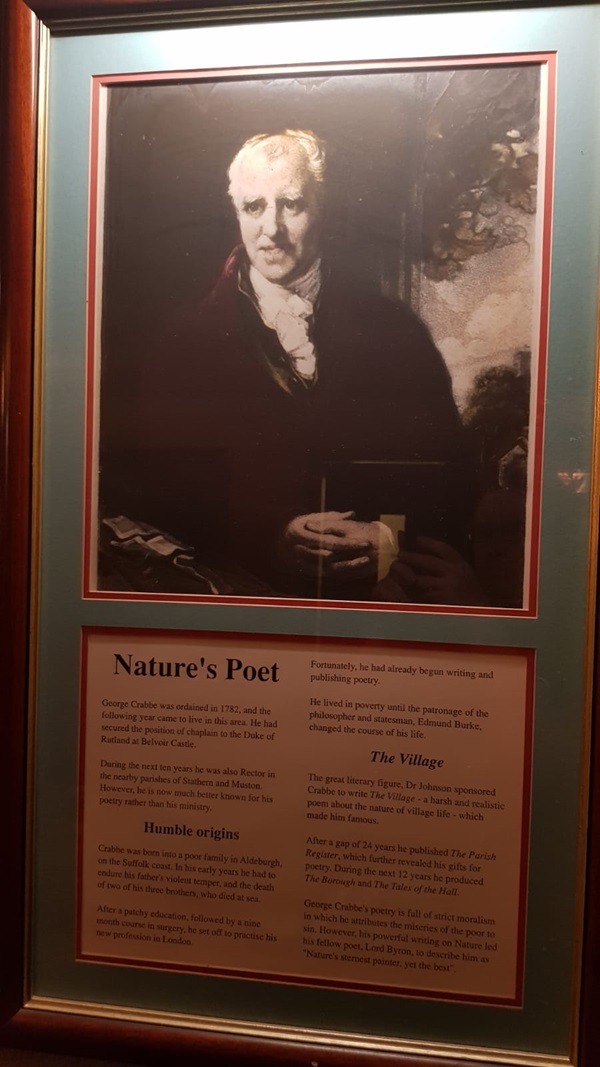
The text reads: George Crabbe was ordained in 1782, and the following year came to live in this area. He had secured the position of chaplain to the Duke of Rutland at Belvoir Castle.
During the next ten years he was also Rector in the nearby parishes of Stathern and Muston. However, he is now much better known for his poetry rather than his ministry
Crabbe was born into a poor family in Aldeburgh, on the Suffolk coast. In his early years he had to endure his father’s violent temper, and the death of two of his three brothers, who died at sea.
After a patchy education, followed by a nine month course in surgery, he set off to practise his new profession in London.
Fortunately, he had already begun writing and publishing poetry.
He lived in poverty until the patronage of the philosopher and statesman, Edmund Burke, changed the course of his life.
The great literary figure, Dr Johnson sponsored Crabbe to write The Village – a harsh and realistic poem about the nature of village life – which made him famous.
After a gap of 24 years he published The Parish Register, which further revealed his gifts for poetry. During the next 12 years he produced The Borough and The Tales of the Hall.
George Crabbe’s poetry is full of strict moralism in which he attributes the miseries of the poor to sin. However, his powerful writing on Nature led his fellow poet, Lord Byron, to describe him as “Nature’s sternest painter, yet the best”.
Prints and text about a royal assignation.
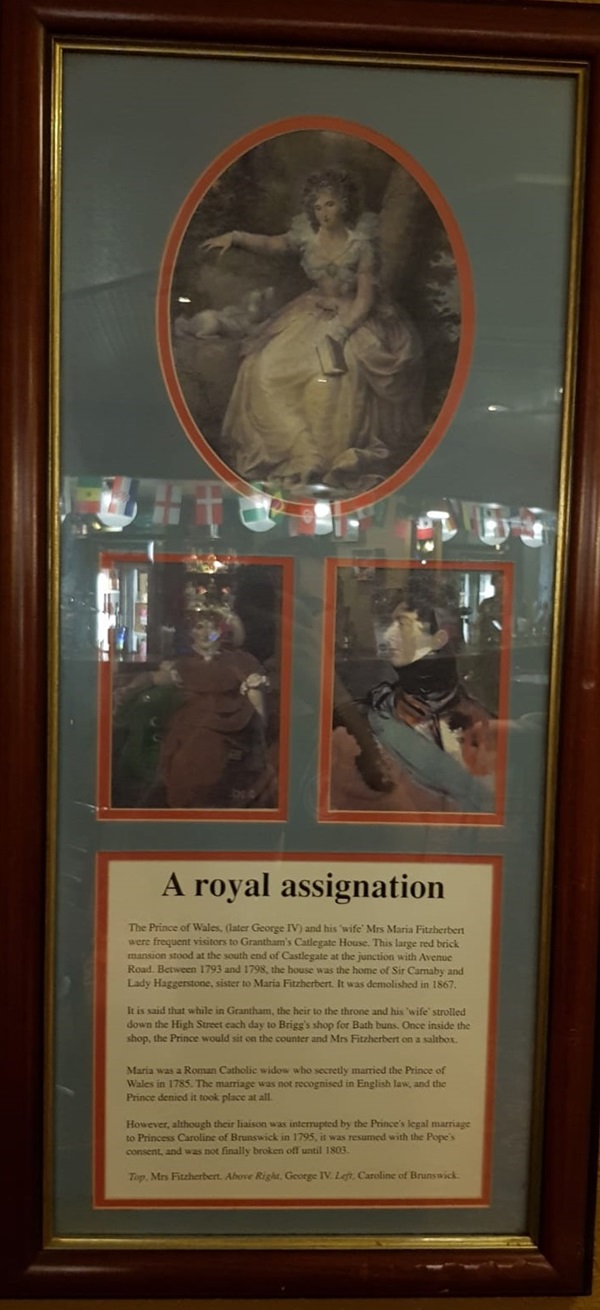
The text reads: The Prince of Wales, (later George IV) and his ‘wife’ Mrs Maria Fitzherbert were frequent visitors to Grantham’s Castlegate House. This large red brick mansion stood at the south end of Castlegate at the junction with Avenue Road. Between 1793 and 1798, the house was the home of Sir Carnaby and Lady Haggerstone, sister to Maria Fitzherbert. It was demolished in 1867.
It is said that while in Grantham, the heir to the throne and his ‘wife’ strolled down the High Street each day to Brigg’s shop for Bath buns. Once inside the shop, the Prince would sit on the counter and Mrs Fitzherbert on a saltbox.
Maria was a Roman Catholic widow who secretly married the Prince of Wales in 1785. The marriage was not recognised in English law, and the Prince denied it took place at all.
However, although their liaison was interrupted by the Prince’s legal marriage to Princess Caroline of Brunswick in 1795, it was resumed with the Pope’s consent, and was not finally broken off until 1803.
Illustrations and text about St Wulfram’s.

The text reads: For hundreds of years the beautifully proportioned spire and tower of St Wulfram’s Church have been the reference point for those travelling to and from Grantham.
This fine parish church, which still dominates the modern town, was built over a period of 400 years. The first church on the site was established in the 10th century, possibly to house some relics of Saint Wulfram, brought back to Grantham from France by Queen Editha, wife of Edward the Confessor.
A second and much larger building was erected on this site in the 1100s. This Norman church underwent substantial rebuilding in the 12th century, which took more than 200 years to complete.
On the 4th December 1290 a royal funeral courtege broke its journey in Grantham. The body of Queen Eleanor, wife of Edward I, spent the night in St Wulfram’s before resuming its final journey to Westminster.
Photographs and text about the ‘Dambuster’ and ‘Bomber’ Harris.
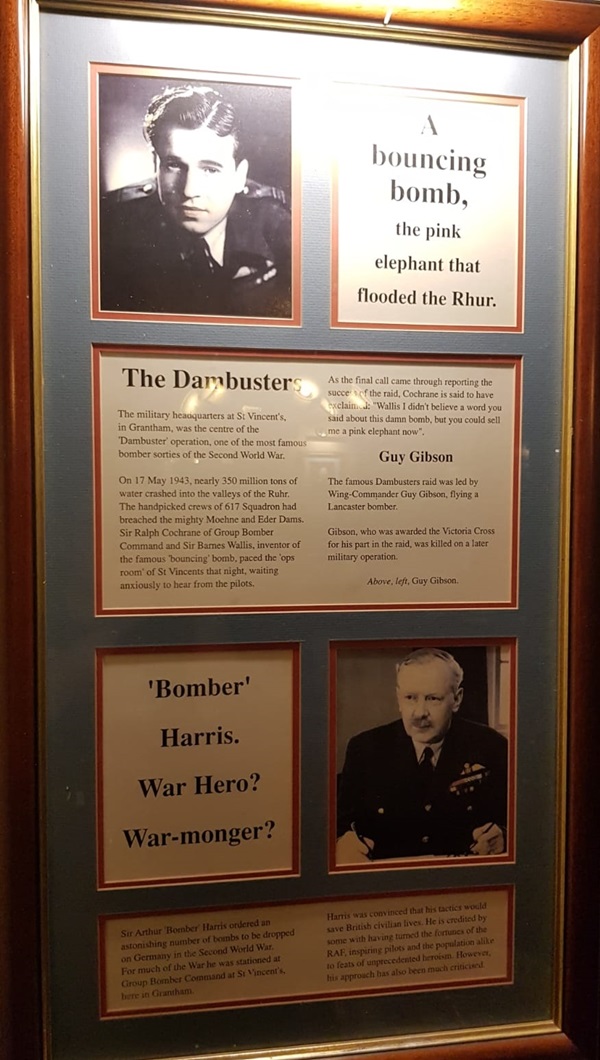
The text reads: The military headquarters at St Vincent’s, in Grantham, was the centre of the ‘Dambuster’ operation, one of the most famous bomber sorties of the Second World War.
On 17 May 1943, nearly 350 million tons of water crashed into the valleys of the Ruhr. The handpicked crews of 617 Squadron had breached the mighty Moehne and Eder Dams. Sir Ralph Cochrane of Group Bomber Command and Sir Barnes Wallis, inventor of the famous ‘bouncing’ bomb, paced the ‘ops room’ of St Vincent’s that night, waiting anxiously to hear from the pilots.
As the final call came through reporting the success of the raid, Cochrane is said to have exclaimed: “Wallis I didn’t believe a word you said about this damn bomb, but you could sell me a pink elephant now”.
The famous Dambusters raid was led by wing-commander Guy Gibson, flying a Lancaster bomber.
Gibson, who was awarded the Victoria Cross for his part in the raid, was killed on a later military operation.
Sir Arthur ‘Bomber’ Harris ordered an astonishing number of bombs to be dropped on Germany in the Second World War. For much of the War he was stationed at Group Bomber Command at St Vincent’s, here in Grantham.
Harris was convinced that his tactics would save British civilian lives. He is credited by some with having turned the fortunes of the RAF, inspiring pilots and population alike to feats of unprecedented heroism. However, his approach has also been much criticised.
Photographs and text about Margaret Thatcher.
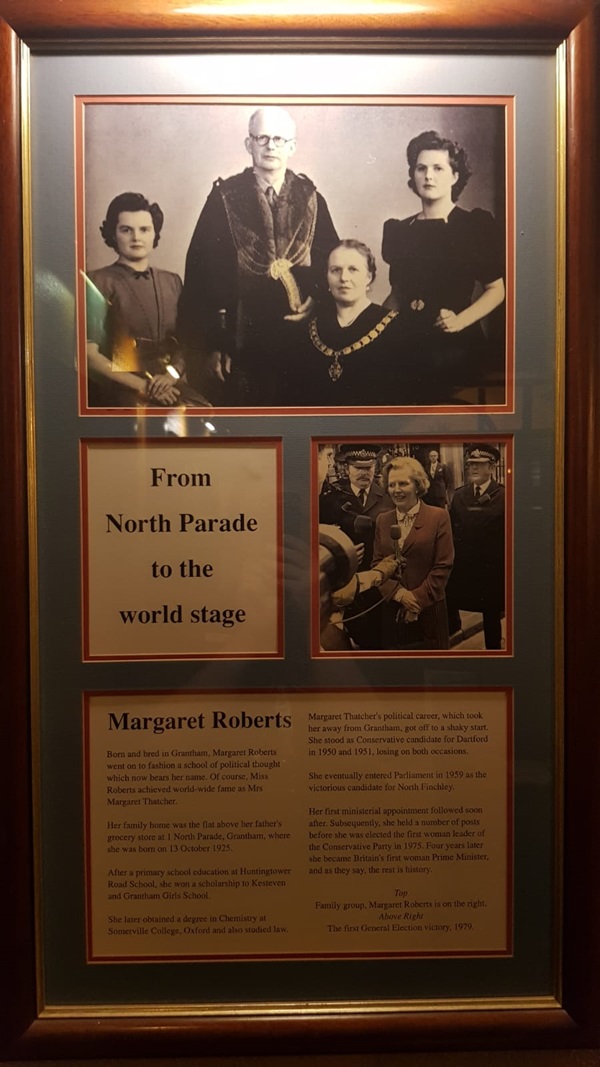
The text reads: Born and bred in Grantham, Margaret Roberts went on to fashion a school of political thought which now bears her name. Of course, Miss Roberts achieved world-wide fame as Mrs Margaret Thatcher.
Her family home was the flat above her father’s grocery store at 1 North Parade, Grantham, where she was born on 13 October 1925.
After a primary school education at Huntingtower Road School, she won a scholarship to Kesteven and Grantham Girls School.
She later obtained a degree in chemistry at Somerville College, Oxford and also studied law.
Margaret Thatcher’s political career, which took her away from Grantham, got off to a shaky start. She stood as Conservative candidate for Dartford in 1950 and 1951, losing on both occasions.
She eventually entered Parliament in 1959 as the victorious candidate for North Finchley.
Her first ministerial appointment followed soon after. Subsequently, she held a number of posts before she was elected the first woman leader of the Conservative Party in 1975. Four years later she became Britain’s first woman prime minister, and as they say, the rest is history.
A print and text about Robert Owen.
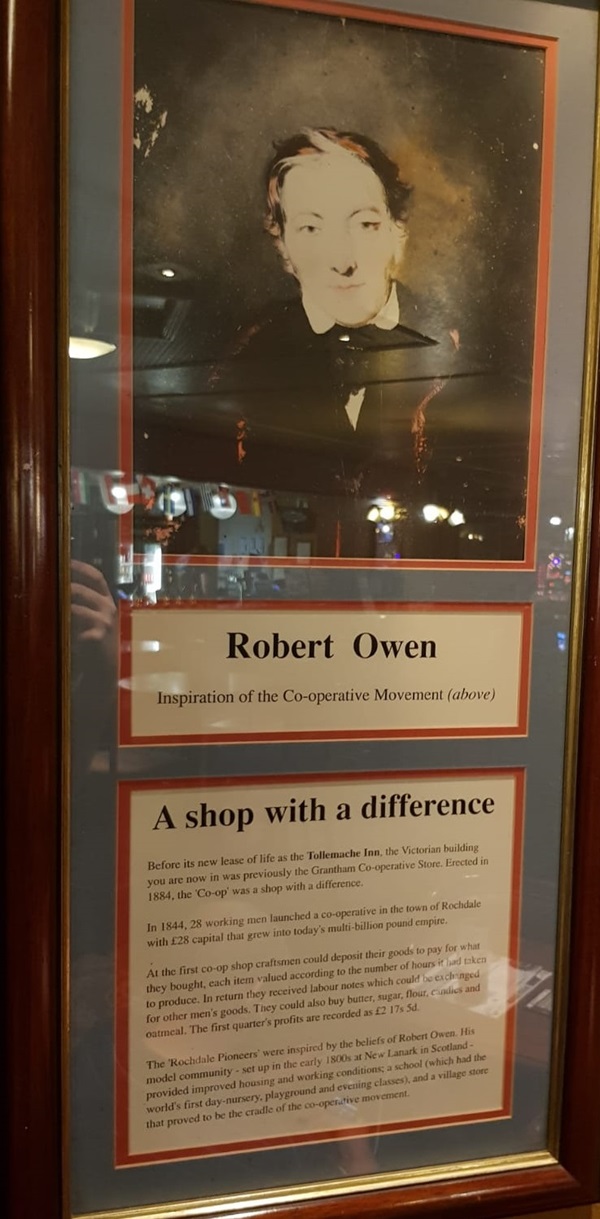
The text reads: Before its new lease of life as the Tollemache Inn, the Victorian building you are now in was previously the Grantham Co-operative Store. Erected in 1884, the Co-op was a shop with a difference.
In 1844, 28 working men launched a Co-operative in the town of Rochdale with £28 capital that grew into today’s multi-billion pound empire.
At the first Co-op shop craftsmen could deposit their goods to pay for what they bought, each item valued according to the number of hours it had taken to produce. In return they received labour notes which could be exchanged for other men’s goods. They could also buy butter, sugar, flour, candles and oatmeal. The first quarter’s profits are recorded as £2 17s 5d.
The ‘Rochdale Pioneers’ were inspired by the beliefs of Robert Owen. His model community – set up in the early 1800s at New Lanark in Scotland – provided improved housing and working conditions; a school (which had the world’s first day-nursery, playground and evening classes), and a village store that proved to be the cradle of the Co-operative movement.
An illustration of Co-operative Stores Grantham.
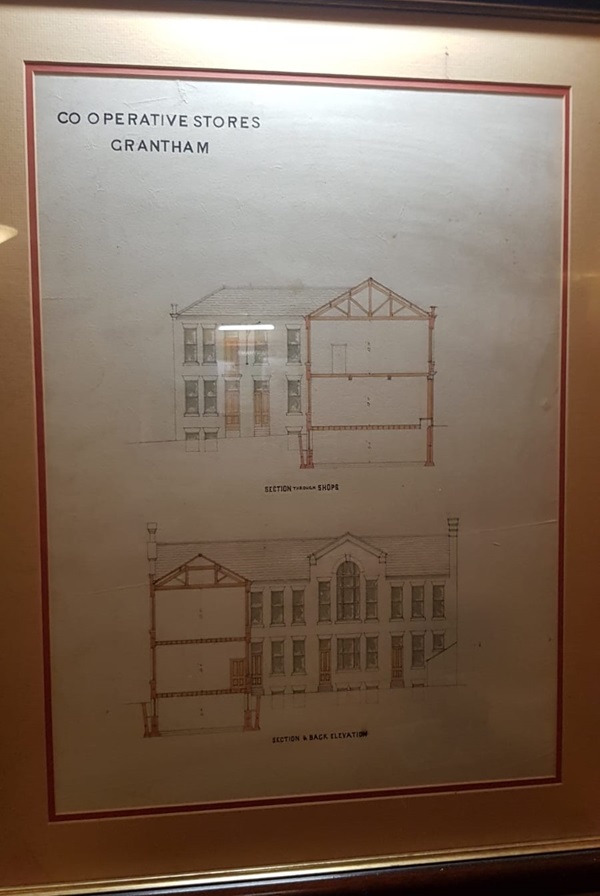
A photograph of High Street, Grantham, c1908.
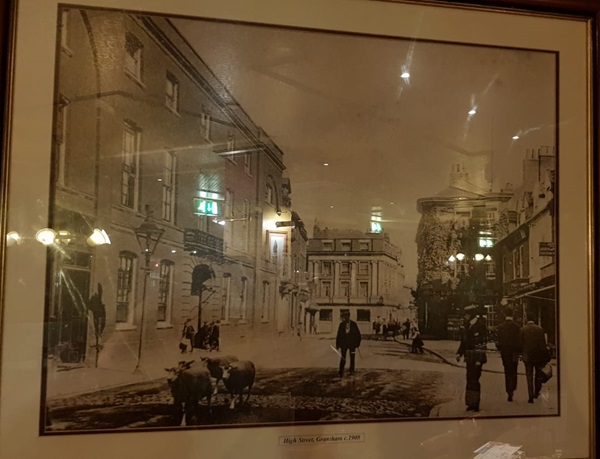
Photographs of Grantham Railway Station.
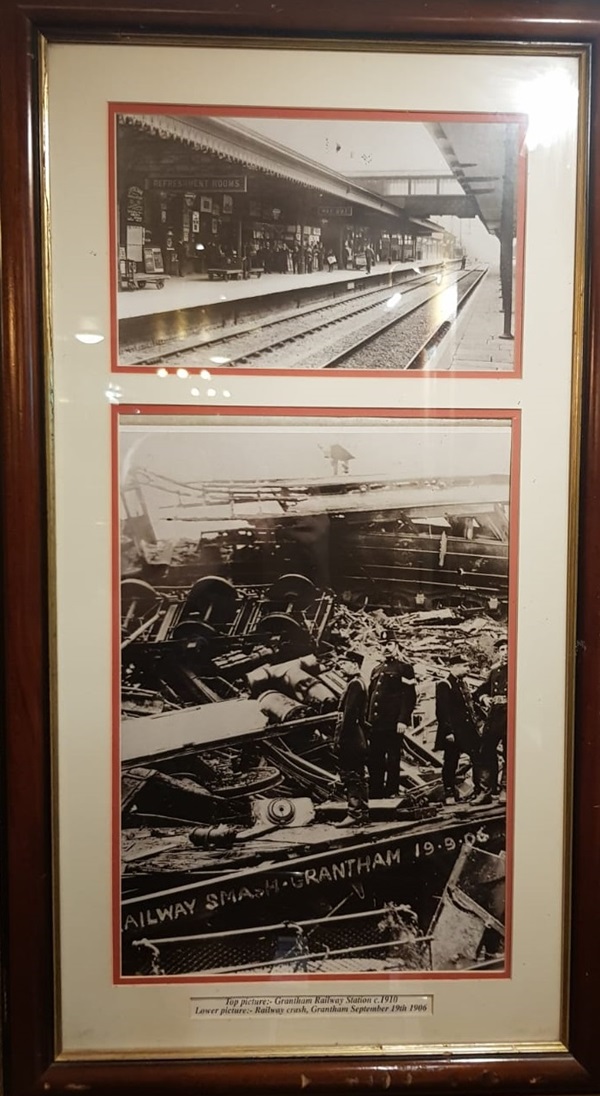
Top picture: Grantham Railway Station, c1910
Lower picture: Railway crash, Grantham, September 19 1906.
A photograph of St Peter’s Hill, Grantham, c1906.
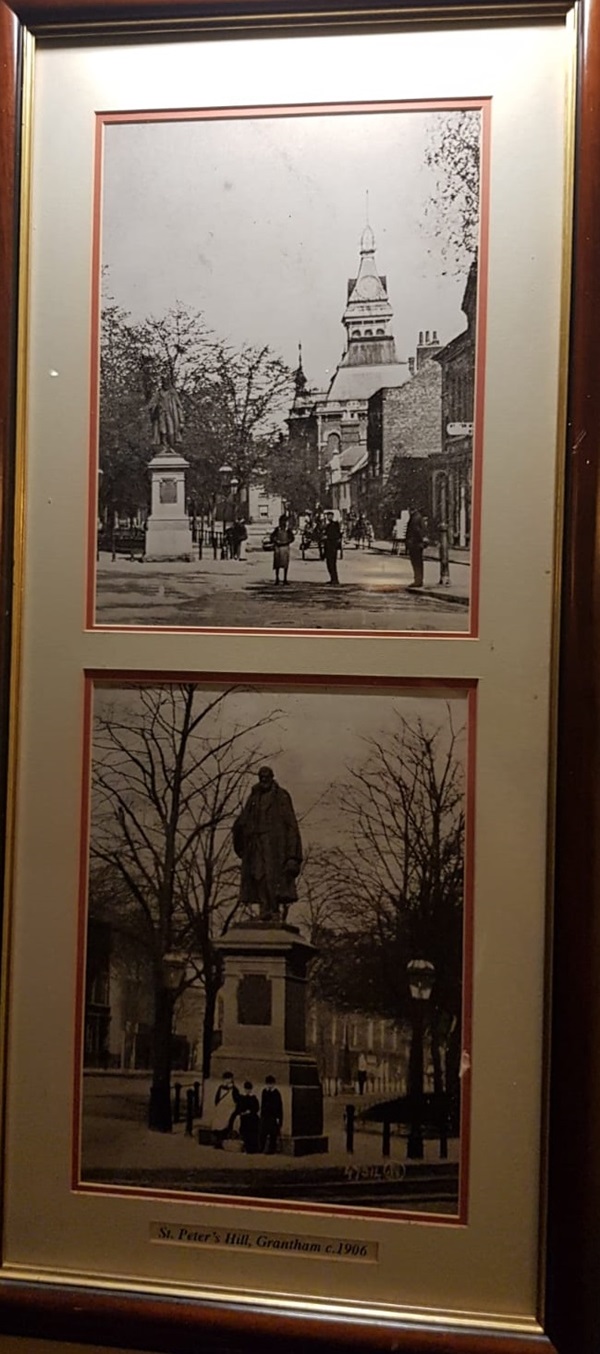
External photograph of the building – main entrance.
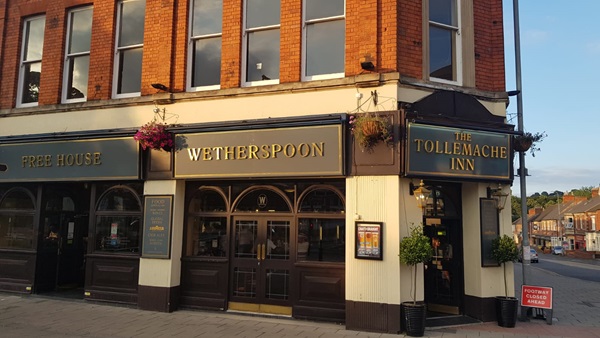
If you have information on the history of this pub, then we’d like you to share it with us. Please e-mail all information to: pubhistories@jdwetherspoon.co.uk